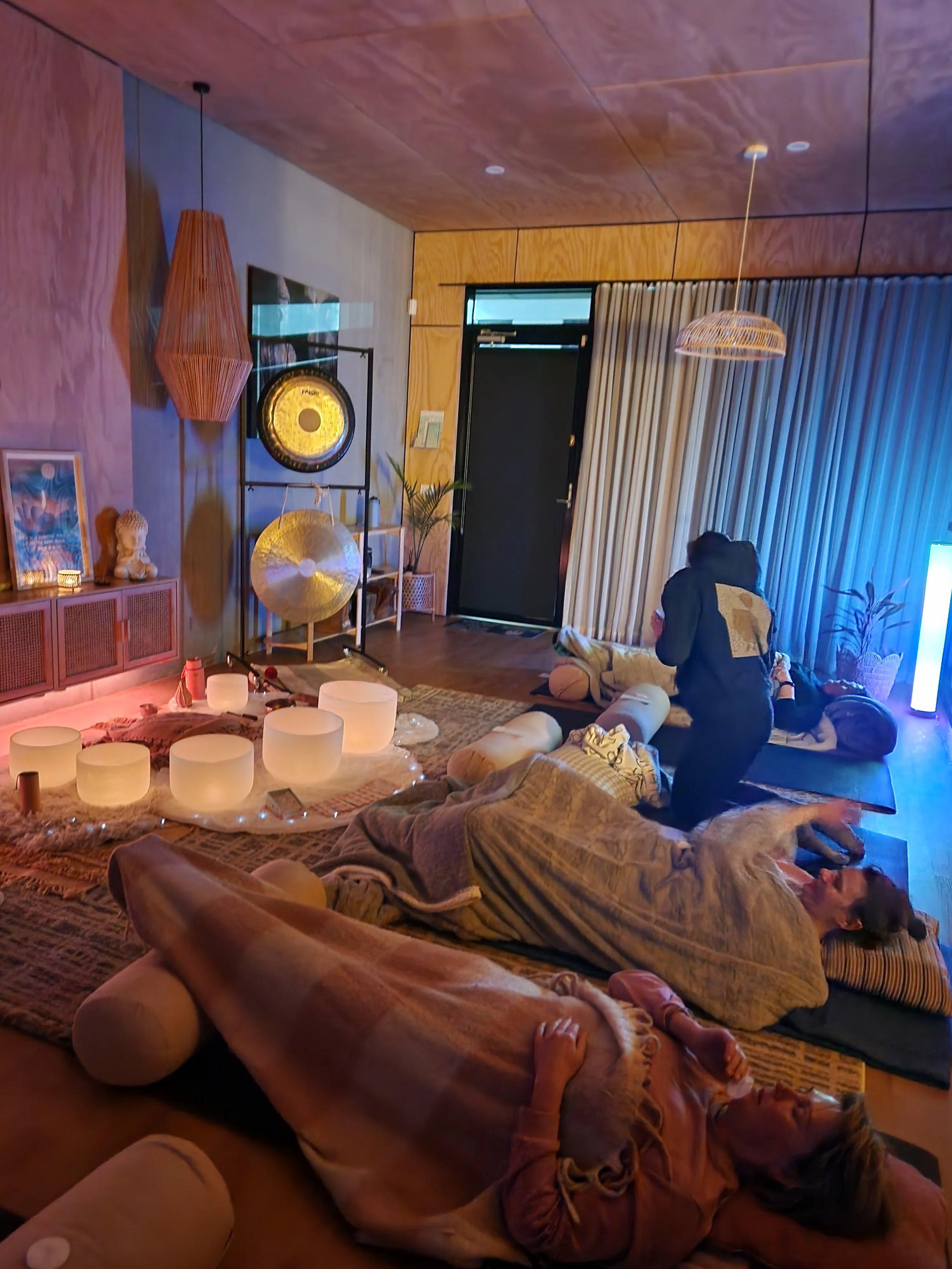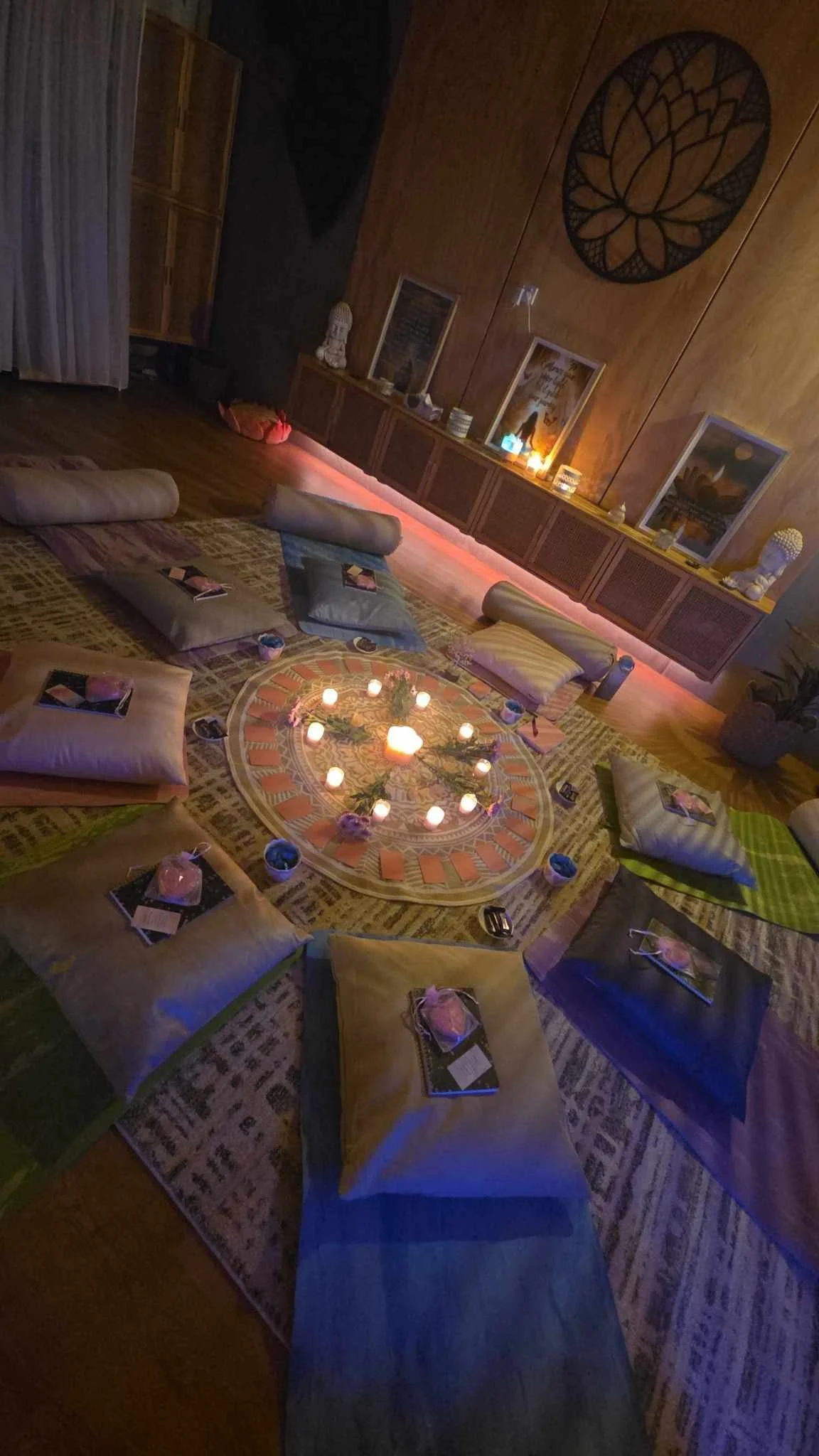YOGA:
Come join our various classes held by highly qualified and experienced instructors in a wide range of modalities.
Beginner or experienced there is something to suit every body and we understand that all bodies are different and move in different ways. You will be guided by our instructors who can modify any shape to suit you that will help you benefit from the movements and make sure you enjoy your experience. It is all about you and not trying to achieve impossible poses that make you feel despondent. Over time you will find that your body will naturally adapt more easily to movements and help you gain the many health benefits that yoga can offer for your body, mind and soul.
All props are provided for your comfort and safety - quality mats, bolsters, blocks, straps, eye pillows, blankets and pillows.
We have a beautiful, welcoming environment and all you need to bring is yourself and a water bottle if preferred. After class we encourage community connection for you to sit and chat, enjoy a cuppa or just chill before heading off for the rest of your day/night.
YIN YOGA
Yin Yoga focuses on long slow holds of poses using body weight and gravity to lengthen and stretch muscles and allow deep connective tissues, such as ligaments and the fascia, to expand over time. This can help to release muscle tension and tightness and reduce the risk of injury in the targeted areas as it stimulates collagen and elastin production in the joints.
Over time you will notice improved flexibility as the joints are lubricated and increase their range of motion. This assists in maintaining joint health and can potentially prevent degeneration due to age or over-use from high impact sports etc.
Other benefits -
Enhanced circulation - from the stimulation of the flow of energy through the body's meridians.
Improved posture - addressing imbalance and strengthening core muscles.
Focus on deep breathing - calms the mind, restores metabolism and aids in the regulation of the bodily systems.
Reduced stress and anxiety - reduces stress hormones and promotes a sense of relaxation
Emotional release - helps release stored emotions and promote emotional healing.
Increased energy - balancing the body and mind can improve energy levels and reduce feelings of fatigue.
MEDITATION
Meditation is a practice that uses various mental and physical techniques to focus attention, cultivate mindfulness, and achieve a state of calm and mental clarity. By intentionally training awareness to the present moment, rather than getting lost in thoughts, individuals can reduce stress and anxiety, improve focus, and enhance overall emotional well-being. Common techniques include focusing on the breath, sounds, body sensations, or a mantra, with the goal of developing inner peace and mental resilience.
Key Aspects of Meditation
Focus:
It involves concentrating your attention on a single point, such as your breathing, a mantra (a repeated word or phrase), a sensation, or a visual image.
Awareness:
The goal is to become more aware of your thoughts, feelings, and bodily sensations without judgment.
Mindfulness:
Many meditation practices, like mindful meditation, involve bringing your attention to the present moment and observing your thoughts as they arise and pass.
Calm & Clarity:
Through practice, meditation helps achieve a more stable and calm mental state, detaching from constant, reactive thinking.
Common Meditation Techniques
Focused Attention: Directing your attention to a single point, such as your breath.
Mindfulness Meditation: Paying attention to the present moment without judgment.
Mantra Meditation: Repeating a word, phrase, or sound to focus the mind.
Movement Meditation: Maintaining focus and self-awareness while engaging in physical activity.
Loving-Kindness Meditation: Cultivating feelings of compassion and goodwill towards oneself and others.
Benefits of Meditation
Reduced Stress and Anxiety: Helps manage and reduce feelings of stress and anxiety.
Improved Focus: Sharpens attention and concentration.
Enhanced Emotional Health: Boosts overall emotional well-being and resilience.
Greater Self-Awareness: Fosters a deeper understanding of one's own thoughts and emotions.
WOMEN’S CIRCLES
A women's circle is a sacred, judgment-free gathering of women who come together for mutual support, sharing, and connection in a safe, intentional space. These ancient-rooted traditions foster personal growth and collective wisdom by offering women a place to be seen, heard, and honored without hierarchy or interruption, often facilitated by rituals, meditations, or sharing circles that allow for deep authenticity and empowerment.
What Happens in a Women's Circle?
Sharing and Witnessing:
Participants use a "talking stick" or similar object to ensure each woman has an uninterrupted opportunity to share her experiences, challenges, and feelings.
Rituals and Ceremonies:
Circles often incorporate symbolic rituals, such as using crystals, flowers, candles, or elements like wool and threads, to create a sacred space and hold intention.
Activities:
Circles may include meditation, yoga, journaling, singing, and creative or therapeutic activities to foster connection and healing.
Intention Setting:
Hosts often set a guiding intention for the circle, which could be related to grief, healing, a bridal blessing, menopause, or simply fostering community.
Key Principles
Safety and Support:
Circles are a sanctuary where women can feel safe to be vulnerable, express their true selves, and find support without judgment.
Equality and No Hierarchy:
There is no leader in a true sense, as each woman's voice and presence are equally important and honored.
Empowerment and Connection:
The gathering aims to help women connect with their own feminine energy, their communities, and each other, fostering collective power and wisdom.
Authenticity:
It provides an authentic space, free from the pressure of "putting on a brave face," allowing for deep, heartfelt sharing.
Historical Context
Ancient Roots:
The practice of women's circles dates back to ancient times, with women gathering to support one another during rites of passage and to share wisdom.
Lunar and Seasonal Cycles:
These ancient circles often coincided with lunar cycles and seasonal changes, with the moon seen as a symbol of the divine feminine.
Modern Revival:
The tradition has seen a resurgence in recent years, offering a counterpoint to modern isolation and a need for deeper community and connection.
INTUITIVE YOGA
This class focuses on checking in with everyone to see what parts of the body we need to work on. Slow flow moving in and out of shapes to target specific areas of the body and varying movements accordingly.
At the last 10 minutes we wind down with relaxation - using body scans, mindfulness and breathing to complete the practice.
SOUND HEALING
Sound healing is an ancient, non-invasive therapy that uses sound vibrations from instruments like singing bowls, gongs, and tuning forks, along with the therapist's voice, to promote physical and mental well-being. By creating frequencies and harmonics, it aims to synchronize brain waves, stimulate the body's natural healing processes, reduce stress, alleviate pain, and induce deep relaxation and mental clarity.
How it Works
Vibrational Effects:
The sounds and vibrations from the instruments resonate through the body, which is largely composed of water, promoting circulation, energy flow, and tissue oxygenation.
Brain Wave Synchronization:
The frequencies of sound can synchronize with the brain's electrical rhythms, helping to guide the nervous system into a more balanced and relaxed state.
Endorphin Release:
Sound stimulation can trigger the release of endorphins, the body's natural painkillers, which can help alleviate symptoms of chronic pain and anxiety.
Stress and Cortisol Reduction:
The process can lower stress levels and reduce cortisol, leading to a calmer and more restorative physical state.
Common Instruments Used
Singing Bowls: Both Himalayan and crystal singing bowls are used.
Gongs: These produce deep, resonant sounds that can have a profound effect.
Tuning Forks: These create specific, low-frequency vibrations.
Chimes and Bells: These are used to create high-frequency sounds for mental stimulation.
Voice: The therapist's voice, through chanting or singing, can also be used as a healing instrument.
Benefits of Sound Healing
Stress Reduction: Induces deep relaxation and calms the nervous system.
Pain Relief: Can alleviate symptoms of chronic pain by stimulating pain-relieving endorphins.
Mental Clarity: Higher frequencies can enhance clarity and stimulate creativity.
Improved Sleep: Helps in achieving states of relaxation conducive to better sleep.
Reduced Inflammation: Promotes tissue oxygenation, which can reduce inflammation.
Energetic Rebalancing: Aims to clear energetic blockages and restore harmony in the body.
SPINAL ENERGETIC CONTAINERS - SOULE
In Spinal Energetics, a container refers to the intentional, safe, and holding space created within a session or group environment, allowing for emotional release, energetic recalibration, and profound transformation to occur without the practitioner needing to force communication or healing. This container provides the necessary energetic and emotional safety for individuals to unwind, release stored tension and stress, and reconnect with their true essence in a gentle, present, and unique way.
What happens in a container?
Space for Release:
The container provides a safe space for the body to let go of stored tension, trauma, and unprocessed emotions, which can manifest as physical sensations, emotions, or insights.
Energetic Connection:
Practitioners work within the energetic field of the body, often using light physical touch, breath, and voice to facilitate a deeper connection to the client's energy system.
Unwinding and Reconnection:
The aim is to give the body and system the space to unwind and release stress, which helps to release tension and bring about a profound reconnection to one's true essence.
Individualized Experience:
Each container is unique, meeting individuals where they are at in their healing journey, whether they are still and internal or expressive and moving.
Presence and Witnessing:
The emphasis is on presence, with the practitioner meeting, witnessing, and holding the energy of the client, fostering a sense of depth and intimacy.
How is the container created?
Intentional Environment:
The physical and energetic spaces are intentionally created to support the energetic shifts and transformations that occur during a session, according to Kirsty Saunders.
Limited Participants:
In group sessions, spaces are often intentionally limited to maintain the intimacy and depth of the container for the collective experience, according to Humanitix.
Practitioner Guidance:
The practitioner's presence and ability to hold steady in challenging situations are crucial to creating a supportive container for others, according to Medium.



